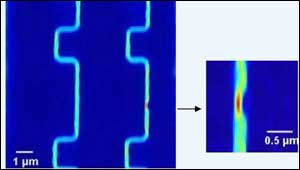Power and Electrical Engineering
This topic covers issues related to energy generation, conversion, transportation and consumption and how the industry is addressing the challenge of energy efficiency in general.
innovations-report provides in-depth and informative reports and articles on subjects ranging from wind energy, fuel cell technology, solar energy, geothermal energy, petroleum, gas, nuclear engineering, alternative energy and energy efficiency to fusion, hydrogen and superconductor technologies.

Powering Fuel Cells: Oxide Materials that "Exhale and Inhale" May Facilitate Small-scale Hydrogen Production
A unique group of oxide materials that readily gives up and accepts oxygen atoms with changes in temperature could be the basis for a small-scale hydrogen production system able to power fuel cells in homes — and potentially in automotive applications.
Scientists have long known that oxides of the rare earth elements cerium (Ce), terbium (Tb), and praseodymium (Pr) can produce hydrogen from water vapor and methane in continuous “inhale and exhale” cycles. By doping iron atoms into the oxid

Making Wind Power More Efficient
A University of Ulster researcher has come up with a new method, using Artificial Intelligence techniques, to forecast wind energy more accurately than ever before.
Predicting how fast the wind will blow has always been a major problem for wind farm operators. It is essential that they have some idea of how much electricity they will be able to produce each day based on the strength of the wind.
Energy forecasting has become a critical factor in the efficient generation of power from w

Project pairs coal with fuel cells to create cleaner, more efficient power
Ohio University engineers are leading one of the first comprehensive efforts to examine how fuel cell technology could pave the way for cleaner coal-fired power plants. Supported by a $4 million U.S. Department of Energy grant secured by the Ohio Congressional delegation, the project aims to find ways to use coal – the environmentally dirtiest but most abundant fossil fuel in the world — to harness high-efficiency fuel cells.
Most government-sponsored energy research is focused on using nat

A more efficient, lighter device that generates up to three times more electricity from waves
The world’s oceans hold the key to our future electricity needs. And their potential for producing power has yet to be fully exploited in terms of sustainable energy. The EUREKA WWEC project team hopes to bring exploitation of this renewable energy source a big step forward.
“We’ve developed a device that generates energy from the sea as easily as a wind turbine would do on land,” explains William Dick, managing director of the Irish company Wavebob that led the project. “There’s an awful lo

New sensor bares faults in smallest possible, most advanced circuits
A new scanning microscope developed at Brown University can uncover defects in the smallest and most complex integrated circuits at a resolution 1,000 times greater than current technology. The scanner removes a barrier to further shrinking of integrated circuits: As circuits get smaller, non-visual defects become harder to find.
“This microscope will allow manufacturers to find defects in each embedded wire in ever-tinier circuits,” said Brown University professor Gang Xiao. He developed th

Infrared thermography
Thermography provides the easy checking of points throughout an electric system where faults may arise, and with sufficient warning in order to correct the fault before things get worse.
Infrared thermography provides the visualisation of temperature differences arising at the surfaces of objects. The tool used is a portable and autonomous camera (similar to a home video camera) which is equipped with a detector which permits the measurement and visualisation of thermal images.
Th